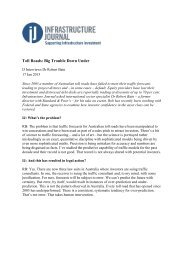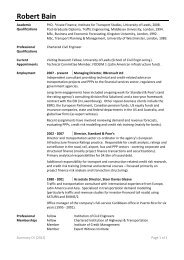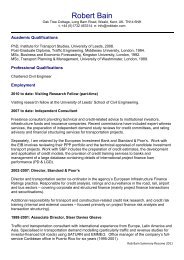Disincentivising overbidding for toll road concessions
Disincentivising overbidding for toll road concessions
Disincentivising overbidding for toll road concessions
- No tags were found...
Create successful ePaper yourself
Turn your PDF publications into a flip-book with our unique Google optimized e-Paper software.
DISINCENTIVISING OVERBIDDING FOR TOLL ROAD CONCESSIONS<br />
Invitation to tender<br />
Actual competition <strong>for</strong> the franchise takes place once the ITT is published. The most important aspect of the ITT is<br />
the base-service specification, as agreed by the Secretary of State <strong>for</strong> Transport, which outlines the duration of the<br />
franchise, any franchise-specific contract conditions, and the service and investment requirements that are expected<br />
of the winning bidder. This specification is used as the basis <strong>for</strong> appraisal of bidders’ submissions, although the DfT<br />
explicitly aims to ensure that it is not over-specified so as to allow <strong>for</strong> innovation and flexibility in the delivery of train<br />
services over the course of the franchise.<br />
Appraisal<br />
As well as considering the financial aspects of bids, the DfT assesses the deliverability and quality of the bidders’<br />
proposals so as to be confident that the successful bidder is able to deliver on the commitments made in the bidding<br />
process. For this assessment, bidders are required to produce a set of ten delivery plans, as outlined in Table 4.1.<br />
Table 4.1 Delivery plans in rail franchising<br />
Delivery plan Weighting (%)<br />
Organisation, staffing and stakeholder relations, mobilisation and migration 7<br />
Management and delivery of change (including sustainability and the environment) 14.5<br />
Modelling change and profit sharing 7<br />
Marketing and fares 7<br />
Ticket sales and revenue protection 7<br />
Timetabling to accommodate current demand and future growth 14.5<br />
Rolling stock, depots and train maintenance 7<br />
Operational per<strong>for</strong>mance improvement 7<br />
Stations and accessing the network 14.5<br />
Improving service quality 14.5<br />
Source: Department <strong>for</strong> Transport (2012), ‘InterCity West Coast Franchise – Invitation to Tender’, January 20th.<br />
Each bidder’s <strong>for</strong>ecast revenues are split into exogenous and endogenous revenue-affecting factors. The <strong>for</strong>mer are<br />
factors, such as national GDP, that would have an impact on the expected revenues of all bidders, but are outside<br />
of managerial control. These are compared against a DfT revenue benchmark. If a bidder’s assessment of these<br />
exogenous factors differs from the benchmark, the DfT assesses the evidence provided in the bidder’s submission,<br />
and either:<br />
••<br />
adjusts the exogenous factor <strong>for</strong> all bidders to equal that submitted by the bidder (if the bidder has provided<br />
comprehensive evidence <strong>for</strong> such an adjustment); or<br />
••<br />
adjusts that bidder’s exogenous factor such that it is equal to the DfT benchmark view (if the difference between<br />
the submission and the benchmark is not well-justified).<br />
This means that all bidders end up with a common exogenous revenue factor based on the best available evidence<br />
of the external factors that affect the bidder’s expected revenues—whether the best evidence is the DfT’s initial<br />
benchmark, or a new benchmark adjusted <strong>for</strong> evidence provided by a bidder.<br />
Endogenous factors, on the other hand, are individual to that bidder, since they are within managerial control. The<br />
bidder’s delivery plans are used to <strong>for</strong>m an assessment of the risk-adjusted, endogenous revenue-affecting factors.<br />
This assessment is then combined with the exogenous revenue-affecting factors to derive an overall, risk-adjusted<br />
revenue. For example, if a company submits a high revenue based on a particular, individual management strategy,<br />
but its delivery plans suggest that there is a high degree of risk associated with this strategy, the endogenous<br />
revenue factor would be revised downwards to reflect this risk.<br />
To summarise, each company’s risk-adjusted revenue is there<strong>for</strong>e made up of:<br />
••<br />
a common exogenous revenue factor; and<br />
••<br />
an individual, endogenous revenue factor that is adjusted <strong>for</strong> risk consistent with that company’s delivery plans.<br />
This process is outlined in Figure 4.1.<br />
48






